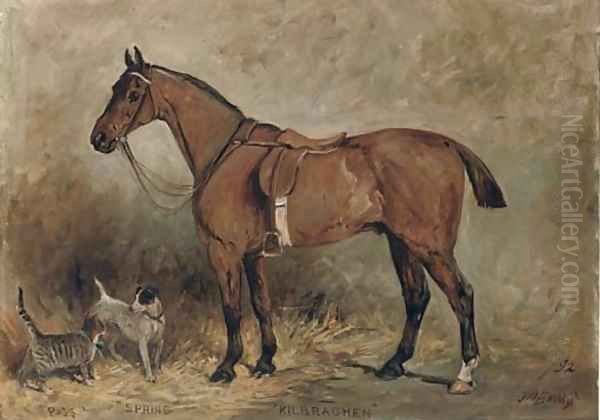
John Emms stands as a significant figure in British art, particularly renowned for his vibrant and lifelike depictions of animals. Active during the latter half of the 19th and early 20th centuries, Emms carved a distinct niche for himself, becoming one of the most sought-after painters of hounds and horses of his time. His work captures the energy, character, and anatomical accuracy of his subjects, reflecting both his artistic skill and his deep understanding of the animals he portrayed.
Early Life and Artistic Formation
John Emms was born in Blofield, Norfolk, England, in 1843. His father, Henry William Emms, was himself an artist, albeit an amateur one. This familial connection to art likely provided an early exposure and encouragement for the young John. Seeking to develop his talents and pursue a professional career, Emms eventually made the pivotal move to London, the heart of the British art world.
In London, Emms's career took a significant step forward when he became a studio assistant to the highly influential and celebrated painter, Frederic Leighton (later Lord Leighton). Leighton was a dominant figure in the Victorian art establishment, eventually serving as President of the Royal Academy. Working in Leighton's studio would have provided Emms with invaluable training, exposure to high artistic standards, and crucial insights into the workings of the London art scene.
Collaboration with Leighton and Entry into Society
The association with Frederic Leighton proved immensely beneficial. Leighton, known for his classical and mythological subjects, represented the pinnacle of academic painting. While Emms's own artistic interests would diverge towards animal painting, the experience gained under Leighton was formative. One notable collaboration involved assisting Leighton on a large-scale mural, The Ten Virgins, destined for St Michael and All Angels Church in Lyndhurst, Hampshire. It is said that Emms contributed elements to this work, including the depiction of an owl, perhaps an early hint at his affinity for capturing living creatures.

More importantly, his connection with Leighton facilitated Emms's entry into the upper echelons of British society. Leighton's patronage and network opened doors, allowing Emms to meet potential clients among the aristocracy and landed gentry – precisely the demographic most interested in commissioning portraits of their prized horses and hounds. This access was crucial for an artist specializing in sporting and animal subjects.
Rise to Prominence and Exhibitions
John Emms began exhibiting his work, gaining recognition for his distinct talent. He made his debut at the prestigious Royal Academy of Arts in London in 1866. Exhibiting at the Royal Academy was a significant milestone for any aspiring artist, offering visibility and critical attention. Emms continued to exhibit there and at other important venues, including the British Institution and the Society of British Artists (later the Royal Society of British Artists).
His reputation grew steadily. By 1875, he was sufficiently established to have three paintings included in a major London exhibition, one of which was titled Beauties of the New Forest. This title points towards his developing connection with the Hampshire region, which would become central to his life and work. His paintings were well-received, admired for their realism and the palpable energy he brought to his animal subjects. He became particularly popular throughout England, receiving numerous commissions.
Artistic Style and Technique
Emms developed a distinctive artistic style characterized by its vitality and directness. While some reports suggest his earliest works featured a more meticulous, precise finish with a glassy surface, he is best known for the looser, more fluid brushwork that marked his mature style. This approach allowed him to convey a sense of movement and immediacy, capturing the fleeting moments of animal behaviour.
Working primarily in oils, Emms demonstrated a masterful handling of the medium. His paintings often feature rich colours and a keen attention to detail, particularly in rendering the textures of fur, the musculature of horses, and the expressive eyes of dogs. However, his later style often employed a more limited, though effective, colour palette, focusing on capturing form and energy with confident, visible brushstrokes. Unlike the sometimes sentimental approach of contemporaries like Sir Edwin Landseer, Emms's work generally maintained a robust realism.
His style can be seen as part of the broader Realist movement influencing art across Europe, prioritizing accurate observation over idealized forms. Yet, Emms infused this realism with a dynamism that made his animal portraits more than mere anatomical studies; they were character studies, full of life.
Focus on Hounds, Horses, and Hunting
John Emms is inextricably linked with the depiction of dogs, especially hounds associated with hunting. Foxhounds, Beagles, Bloodhounds, and various terrier breeds, particularly the Jack Russell Terrier, feature prominently in his oeuvre. He didn't just paint static portraits; he often depicted hounds in groups, capturing their interactions, their eagerness before a hunt, or their repose afterwards. His paintings convey an intimate knowledge of canine behaviour and breed characteristics.
Horses were another major subject. He painted hunters, cobs, and carriage horses, often shown saddled and ready, or standing patiently outside stables. His equine portraits display a similar understanding of anatomy and temperament as his dog paintings. The combination of horses and hounds in hunting scenes became a hallmark of his work, appealing directly to the sporting interests of his clientele.
Emms was himself an enthusiastic huntsman. This personal passion deeply informed his art. His firsthand experience in the field allowed him to portray hunting scenes and the associated animals with an authenticity that resonated with fellow enthusiasts. He understood the postures, movements, and spirit of the animals involved in the chase, translating this knowledge onto the canvas with remarkable skill. His connection to the New Forest area, a region known for its hunts, provided ample inspiration and subject matter.
Notable Works
Throughout his prolific career, John Emms produced numerous memorable paintings. While a comprehensive list is extensive, several works stand out and are representative of his talent:
Feeding the Chickens (1877): An example perhaps showing a broader range of rural subjects early in his career, though less typical of his later specialization.
Ready for Action (1890): Likely depicting hounds, this title suggests the anticipation and energy Emms excelled at capturing before a hunt.
A Saddled Hunter and Jack Russell Terrier (1893): This work exemplifies his skill in portraying both horses and dogs, often showing them together in a stable or field setting, highlighting the relationship between different working animals.
Portrait of a Cob, outside his stable with a Dachshund (1902): Demonstrates his continued work in animal portraiture into the early 20th century, showcasing different breeds and settings.
The New Forest Foxhounds (various): Emms painted the local hunt pack numerous times, capturing the collective energy and individual characters of the hounds. These works are among his most iconic.
Callum (a Dandie Dinmont Terrier): Emms painted specific, named dogs, indicating commissioned portraits. His ability to capture the unique personality of an individual animal was highly valued.
These titles, and many other works like them, cemented Emms's reputation. His paintings often featured hounds lounging in kennels, gathered around stable doors, or interacting playfully, showcasing his versatility in depicting animals in various states of activity and rest.
Life in Lyndhurst and the New Forest
Around 1872, Emms moved to Lyndhurst, Hampshire, a village located in the heart of the New Forest. This move proved definitive for both his life and his art. The New Forest, with its ancient woodlands, heathlands, and strong tradition of hunting, provided the perfect environment and endless inspiration. He became intimately familiar with the local landscape and the New Forest Hunt.
In 1880, John Emms married Fanny Primmer, and the couple settled permanently in Lyndhurst. In 1881, they built a large house and studio named "The Firs," which would remain their home for the rest of Emms's life. Living in Lyndhurst placed him at the centre of a community that appreciated his subjects, and many of his patrons were local landowners and members of the hunt. His presence there further solidified his connection to the sporting life he depicted.
Context: Victorian Animal and Sporting Art
John Emms worked during a period when animal painting and sporting art enjoyed immense popularity in Britain. The Victorian era saw a surge in interest in dog breeding, horse racing, and fox hunting, particularly among the affluent classes. Artists who could skillfully capture these subjects found a ready market.
Sir Edwin Landseer was undoubtedly the towering figure in animal painting during the mid-Victorian period, known for his technical brilliance and often anthropomorphic or sentimental portrayals. Emms emerged in the generation following Landseer, offering a somewhat different, often more direct and less sentimentalized, vision.
Other notable contemporaries specializing in or frequently depicting animals included Briton Rivière, known for his dramatic compositions often featuring animals alongside human figures; Richard Ansdell, who often painted Scottish scenes with animals; and Heywood Hardy, another prominent painter of hunting and equestrian scenes. George Stubbs, though from an earlier era, had set a high standard for equine anatomical accuracy that influenced subsequent generations. Later dog specialists like Maud Earl also worked during the end of Emms's career.
Emms's work fits comfortably within this tradition, yet his vigorous brushwork and focus on the raw energy of hounds gave his paintings a distinct character. He operated alongside major figures of the broader Victorian art scene, such as the Pre-Raphaelites (like Dante Gabriel Rossetti and Sir John Everett Millais) and other establishment giants like Lawrence Alma-Tadema and George Frederic Watts, though his subject matter and style remained firmly rooted in the realm of animal and sporting art.
Later Life, Challenges, and Legacy
Sources suggest John Emms lived a somewhat bohemian lifestyle, enjoying the fruits of his success perhaps too readily. He was known to be generous and possibly improvident, spending money from commissions as it arrived. This approach to finances proved problematic later in life.
Towards the end of his career, Emms suffered from illness, which severely hampered his ability to paint. Without the steady income from new commissions, he and his family faced significant financial hardship, falling into near poverty. This marked a sad end to a career that had brought considerable success and recognition.
John Emms died in Lyndhurst on November 1st, 1912, at the age of 69. He was buried in the cemetery of the Lyndhurst Parish Church, the same church for which he had helped Frederic Leighton complete the mural decades earlier.
Despite the difficulties of his final years, John Emms left behind a substantial body of work that continues to be highly regarded. His paintings are prized by collectors of sporting art and animal portraiture. They appear regularly at auction, often commanding strong prices, a testament to their enduring appeal. His work can be found in numerous private collections and several public institutions.
Emms's legacy lies in his exceptional ability to capture the spirit and vitality of the animals he painted, particularly hounds. His direct, energetic style and his authentic portrayal of the hunting field and kennel life set him apart. He remains a key figure in the history of British animal painting, celebrated for his dynamic compositions and his profound understanding of his beloved subjects. His work offers a vivid window into the sporting life of late Victorian and Edwardian England.
Conclusion
John Emms was more than just a painter of animals; he was a chronicler of a specific aspect of British rural life and culture. His deep connection to his subjects, born from personal passion and keen observation, imbued his canvases with a life and energy that continues to captivate viewers today. From his early training under the esteemed Frederic Leighton to his established career based in the New Forest, Emms navigated the Victorian and Edwardian art world to become a master in his chosen field. His depictions of hounds, horses, and the thrill of the chase remain powerful examples of British sporting art at its finest.